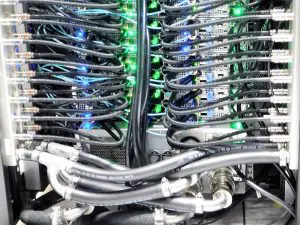Rotary fans have been used to cool electronic devices using forced convection applications to achieve the required heat transfer dissipation. In recent years, there has been an increasing trend to miniaturize the size and maximize the efficiency of the electronic devices which, in turn, increases heat generation. The use of rotary fan cooling conflicts with these new trends due … [Read more...]
Liquid Cooling Options for High-Performance Computing Centers
Figure 1: Liquid cooled 68-node rack at Dell EMC HPC.Ê (Source: CoolIT Systems) Hyperion Research, a company that provides research, analysis, and recommendations for technologies, applications, and markets in high-performance computing and emerging technology areas, forecasts that the worldwide market for high-performance computing (HPC) server systems will grow at a … [Read more...]
Thermal Management of Displays/Signage in Outdoor Enclosures
Introduction/Background The pace of development in the electronics and telecommunication fields has been accelerating in all aspects of the business. For example, electronics/telecommunications equipment has traditionally been housed in large buildings, smaller buildings (sheds) and outdoor cabinets. The introduction of electronics to the outdoor environment has imposed … [Read more...]
INTERVIEW: Dr. Marta Rencz, Mentor Graphics
Dr. Marta Rencz has been nominated for a Lifetime Achievement Award by the ST35 Thermal Hall of Fame. She is a faculty member and former Head of Department at the Budapest University of Technology and Economics, and a member of the Hungarian Academy of Sciences. Dr. Rencz is also the Development Engineering Director of Mentor’s MicReD group, now a Siemens business. Dr. … [Read more...]
Special Challenges In 3D Simulations of Graphite Heat Spreaders
INTRODUCTION Graphite is a naturally occurring form of pure carbon in which the atomic bonds interlock in the layers of a two-dimensional molecular sheet. In nature, dense, rigid graphite ore is mined, purified, and processed into numerous applications, including the inexpensive flexible natural graphite sheets used in electronics. The ore is mechanically reduced and then … [Read more...]
- « Previous Page
- 1
- …
- 25
- 26
- 27
- 28
- 29
- …
- 179
- Next Page »









